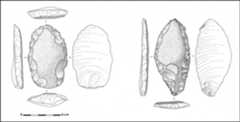1It is in the Jordan Valley that the earliest Chalcolithic sites of Jordan were discovered and studied. In Tulaylat al-Ghassul, eight digs carried out from 1929 to 1938 by the Pontifical Biblical Institute, revealed traces of a culture yet unknown, whose origins stem from the Neolithic period. Since these initial discoveries, a high concentration of sites attributed to this period have been identified; along the Jordan Valley (Abu Hamid, Tabaqat Fahl (Pella) and North Tell al-Shuna), and on the highlands of the plateau (Sahab, Qattar, Abu Snesla and Iraq al-Amir) (fig. II.12).
Figure II.12 — Location map of major sedentary sites for the Chalcolithic period, along with pastoral nomadic camps in desert areas.

2The location of sites is always closely linked to the hydrographic network of wadis that allowed the development of flooded agriculture.In villages, the houses of nuclear families were built using sun-dried bricks, with plastered walls sometimes decorated with remarkable geometric, zoomorphic or anthropomorphic polychrome paintings. Most of the domestic activities of food preparation and craftwork took place in courtyards attached to houses, where the ovens and storage facilities could be found. Large grain silos, like those found at Abu Hamid, reflect the specialization of livelihoods of these people and testify to the emergence of a centralized redistribution of agricultural products. Along with the continued use of carved stone, copper appeared. Although its use is very limited and rare in the domestic context, in Faynan in particular, significant copper mines and work sites are associated with ore deposits.
3In the desert peripheries of Jordan, a recent research has revealed a very different situation.Exploration eastwards in the black basalt desert and in the region of the Azraq oasis, and to the south in the Hisma Basin have revealed the existence of a considerable number of nomadic shepherd camps, on the margins of farming villages in the Jordan Valley and Transjordan plateau (Hibr, Azraq, Quweisa and Jabal al-Jill). Surveys carried out with the support of Ifpo in an unexplored area in Al-Thulaythuwat, near the Saudi border, brought new proof of this Chalcolithic desert culture. The habitat of these semi-nomadic shepherds is represented by circular stone enclosures, with rooms which were once covered with a structure made of light materials: courtyards, storage areas and homes (plate II.9 andII.10,fig. II.13). Livestock pens associated with these camps show the particularity of the livelihood of these people, closer to that of semi-nomadic shepherds from the northern Negev in Palestine or from the north-west of the Hijaz in the south.
Figure II.13 — Flint tools from pastoral nomadic camps in al-Thulaythuwat area (Southern Jordan).

Plate II.9 — General view of stone enclosure at site TH.126 in al-Thulaythuwat area (Southern Jordan).

Plate II.10 — Aerial view of site TH.001 located in the area of al-Thulaythuwat. Semi-nomadic camp with dwelling and animal stone enclosures.


















